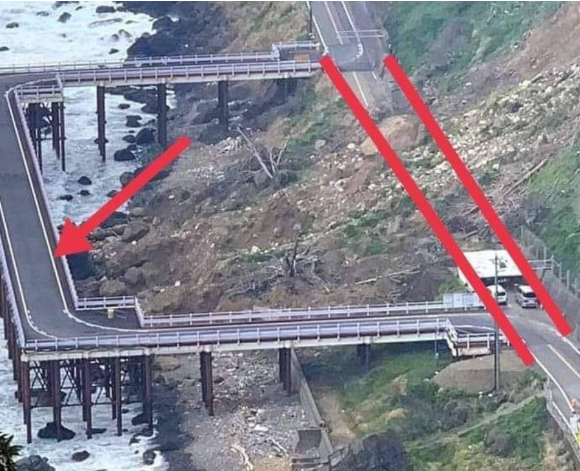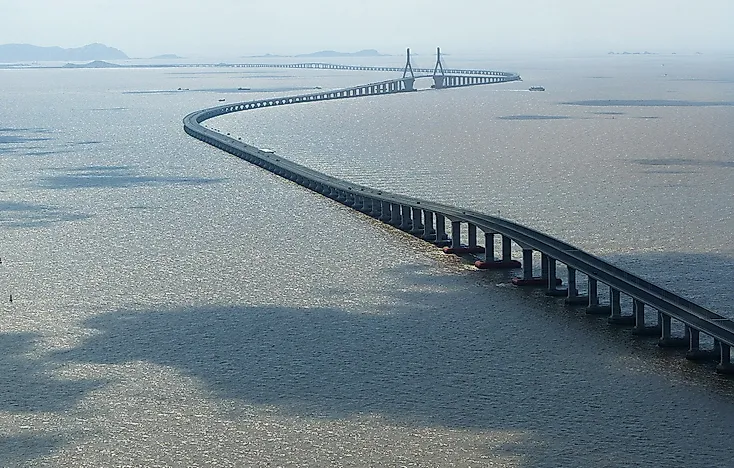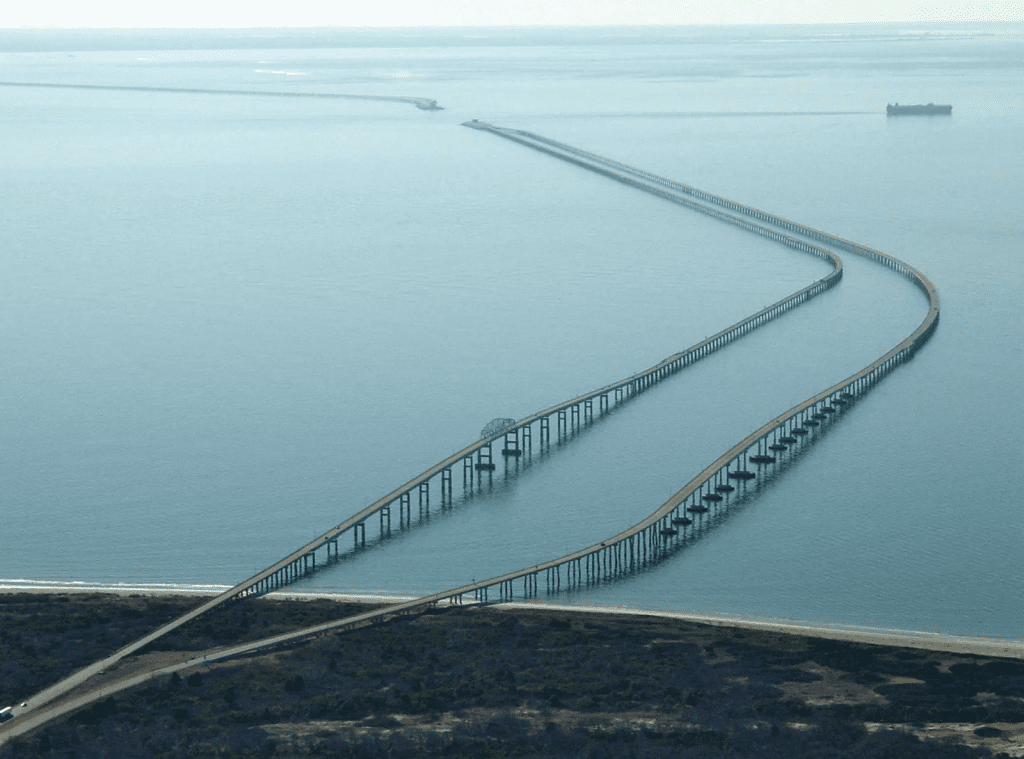Bridges are vital structures that connect places, allowing for safe and efficient transportation over water, valleys, and challenging terrains. While many of us are accustomed to seeing straight, conventional bridges, there are times when bridges take unexpected twists and turns, like the one pictured above. You might wonder: Why did the engineers choose such a design? Wouldn’t a straight bridge be simpler and more cost-effective? The answer lies in the hidden engineering marvels designed to protect these structures and the surrounding environment. Let’s explore why bridges aren’t always built in a straight line and the fascinating reasons behind these unique designs.
The Role of Terrain: Navigating Nature’s Challenges
1. Adapting to the Natural Landscape

When designing a bridge, engineers must consider the specific terrain where it will be built. A straight bridge might seem easier to construct, but if it crosses a rocky shoreline or an area prone to landslides, a straight design could pose serious risks. In rugged landscapes, curved or zigzagged bridges can reduce the strain on structural supports and avoid fragile sections of the land.
2. Avoiding Landslides and Erosion
One of the primary reasons bridges are designed with curves is to protect them from landslides. In areas with unstable slopes, like coastal cliffs, a straight bridge could lead to disastrous consequences if the land shifts. A curved or segmented bridge helps reduce the impact of a landslide by diverting forces away from the main structure. This design choice minimizes the risk of collapse, keeping the bridge intact even if the ground underneath shifts.
Structural Benefits: Why Curved Bridges Are More Resilient
1. Distributing Weight More Effectively
Curved bridges are not just about aesthetics; they are practical solutions to complex engineering challenges. A curved path helps distribute the weight of vehicles and pedestrians more evenly, reducing stress on specific points of the bridge. By dispersing weight along a curve, the bridge can withstand heavier loads and endure environmental stressors like wind and water currents more effectively.
2. Enhancing Stability with Curved Designs
In engineering, stability is crucial. Curved bridges often have greater stability than their straight counterparts when built on unstable terrain. By following a curved path, the bridge can have multiple support points anchored into the ground at different angles. This design enhances its ability to resist seismic activity and reduces the impact of vibrations caused by traffic, making it safer for daily use.
Environmental Considerations: Protecting Natural Habitats
1. Preserving the Surrounding Ecosystem
Curved bridges are frequently chosen to preserve the natural environment. A straight bridge might cut through sensitive ecosystems, potentially harming local wildlife or vegetation. By building around these areas, engineers can protect habitats and avoid disturbing the ecosystem. For example, coastal bridges often curve to minimize their footprint on delicate marine life and coastal plants.
2. Reducing Environmental Impact with Smart Design
Bridges that curve can help reduce environmental impact by following the natural contours of the land. This allows engineers to avoid drilling or excavating large sections of rock or soil, preserving the area’s natural beauty. By minimizing disruption to the land, curved bridges ensure that the construction process is more sustainable and less intrusive on the environment.
Safety First: Mitigating Risks with Curved Bridges
1. Safer in Hazardous Weather Conditions
Bridges exposed to harsh weather conditions, such as strong winds or heavy rains, can benefit from a curved design. A straight bridge might be more vulnerable to wind forces that can push against its sides. In contrast, a curved bridge disperses these forces, making it more stable in high winds. This design feature is particularly important in coastal areas where wind and weather patterns are unpredictable.
2. Easier Maintenance and Long-Term Durability
Curved bridges are also easier to maintain over time. With a straight bridge, certain sections may require more frequent repairs due to concentrated stress points. A curved bridge spreads out these stress points, leading to more balanced wear and tear. This reduces maintenance costs and extends the bridge’s lifespan, making it a cost-effective solution in the long run.
Engineering Ingenuity: Creating Efficient Solutions for Unique Challenges
1. Customizing Bridge Designs to Fit Specific Needs

Engineers design each bridge with specific goals in mind, considering factors like traffic flow, environmental impact, and potential hazards. Curved bridges are often custom solutions that address unique challenges posed by the terrain and location. By thinking outside the box, engineers create bridges that not only serve practical purposes but also enhance the beauty and functionality of the landscape.
2. Showcasing Innovation in Modern Infrastructure
Curved bridges are a testament to human innovation. They showcase how modern engineering can adapt to natural landscapes rather than forcing rigid, straight structures onto the environment. These designs reflect a balance between practicality and creativity, proving that functional infrastructure can be both efficient and aesthetically pleasing.
Examples of Curved Bridges Around the World
There are numerous examples worldwide where curved bridges have been used to overcome natural obstacles and protect the surrounding environment. Here are a few famous examples:

- The Chesapeake Bay Bridge-Tunnel (USA): This bridge features curves to help navigate the vast bay and withstand powerful water currents. It’s designed to reduce environmental impact and protect marine life.
- Hong Kong-Zhuhai-Macao Bridge (China): Spanning over 34 miles, this bridge incorporates curves to navigate the South China Sea’s challenging terrain and reduce the impact of typhoons and heavy waves.
- The Øresund Bridge (Denmark to Sweden): This bridge and tunnel combination includes curved sections to handle strong winds and ensure the bridge’s stability across the Øresund Strait.
Conclusion: Curved Bridges as a Blend of Function and Form
The next time you see a bridge that isn’t perfectly straight, remember that there’s likely a well-thought-out reason behind its design. Curved bridges are far from arbitrary; they’re carefully planned to address the unique challenges posed by the terrain, weather, and environmental impact. These designs are more than just structural solutions – they’re reflections of modern engineering that prioritize safety, sustainability, and resilience.
By building bridges that adapt to nature rather than cutting through it, engineers are creating structures that serve communities while respecting the environment. So, while a straight bridge might seem like the obvious choice, the curves often tell a story of creativity, practicality, and a commitment to building a sustainable future.


